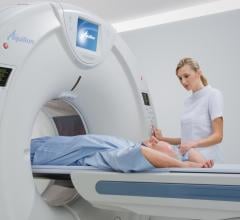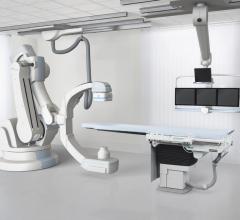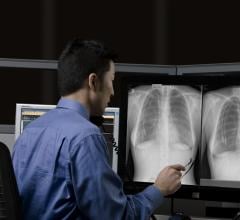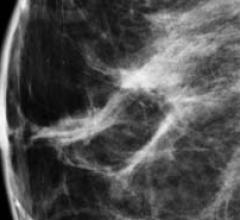April 11, 2012 - Georgian Radiology Consultants, of Barrie, Ontario, installed CARESTREAM DRX-1 systems at each of its six imaging clinics that serve a community of 360,000 centered around Barrie, north of Toronto. The implementation of Carestream’s wireless DR detectors was an integral part of the group’s conversion to an all-digital workflow that began with implementation of a PACS and an EMR. The DRX systems were purchased from and installed by BCL X-Ray Canada Inc., an authorized Carestream distributor.
April 9, 2012 — After witnessing a downtrend for several years, revenues in the U.S. nuclear medicine and positron emission tomography (PET) imaging systems market finally pivoted in 2010. New radiotracers and technologies are expanding the clinical scope and customer base of nuclear medicine and PET imaging. As a result, declines in retrenching areas of the market are poised to be offset by strong growth in emerging end-user market segments.
April 9, 2012 — Healthcare supply contracting company Novation released its 2012 Diagnostic Imaging Watch report. Peer reviewed by members of Novation's Diagnostic Imaging Council, the report is an overview of the latest product technology and trends for imaging subspecialties.
Radiology departments have many different needs and face a wide variety of challenges that can impact their departments ...
April 9, 2012 — New research published in the April issue of The Journal of Nuclear Medicine reveals that systemic inflammation causes an increase in depressive symptoms and metabolic changes in the parts of the brain responsible for mood and motivation. With this finding, researchers can begin to test potential treatments for depression for patients that experience symptoms that are related to inflammation in the body or within the brain.
April 9, 2012 — Elekta announced it has received clearance to CE mark Agility, a beam-shaping device integrated into the head of a linear accelerator (linac). Patients and clinics will benefit from the speed and reliability of this new MLC (multileaf collimator) design.
The U.S. Food and Drug Administration (FDA) has approved the first diagnostic agent to image Alzheimer’s disease beta-amyloid neuritic plaques in the living brain. Previously, the only way to confirm diagnosis of these plaques was from post-mortem biopsies. Eli Lilly and Company and Avid said the FDA cleared the commercial release of florbetapir (Amyvid).
Despite decades of progress in breast imaging, one challenge continues to test even the most skilled radiologists ...
April 6, 2012 — Positron Corp. announced the approval of its Nuclear Regulatory Commission (NRC) manufacturing and distribution license amendment for the company's radiopharmaceutical manufacturing facility in Crown Point, Ind.
April 5, 2012 —Maquet and Siemens Healthcare announced they will collaborate closely to introduce a combined system for diagnostics and surgical procedures. The first systems will be delivered and installed starting May 2012.
April 5, 2012 — The American College of Cardiology (ACC) released a list of “Five Things Physicians and Patients Should Question” in cardiology as part of Choosing Wisely, an initiative of the ABIM Foundation. The list identifies five targeted, evidence-based recommendations that can support physicians in working with their patients to make wise choices about their care.
Bayer Radiology’s Barbara Ruhland and Thom Kinst discuss how radiology departments can address the many different ...
April 5, 2012 – Siemens Healthcare has announced that the Somatom Definition Flash dual-source computed tomography (CT) system with the new Stellar Detector – the first fully integrated detector that virtually eliminates electronic noise – has been cleared by the Food and Drug Administration (FDA) for sale and distribution in the United States. The new Stellar Detector further enhances the already outstanding Somatom Definition Flash CT system by delivering high spatial resolution, generating ultra-thin slices and providing an outstanding level of sharpness in CT at impressively low levels of patient radiation. With the combination of the Somatom Definition Flash CT system and the new Stellar Detector, even the finest image details can now be visualized.
April 5, 2012 - SK Capital Partners, a U.S. based private investment firm, and IBA (Ion Beam Applications S.A.) announced that they have closed on their previously announced agreement to create IBA Molecular, a jointly-owned company derived from IBA’s worldwide radiopharmaceutical division. IBA Molecular is a worldwide leader in the manufacturing and distribution of radioactive isotopes used for medical imaging and therapy, with over 50 locations in the United States, Europe and Asia and employs over 1,000 people. The transaction is valued at approximately €180 million ($239 million). SK Capital will own 60 percent of the recapitalized entity and IBA will retain a 40 percent stake.
April 5, 2012 - Now, the RadiaGuard line includes Beginning and Advanced Treatment Lotions, Post Treatment Cream, Metallic Free Deodorant and two Moisturizing Lip Relief lip treatments. This scientifically advanced skincare system is specifically designed to counteract the effects of radiation and includes natural ingredients like marigold extract, aloe, jojoba oil and Vitamin E. While RadiaGuard products are reasonably priced as individual products, the new set of all products is value-priced at under $85. Further discounts are available to patients at radiation treatment centers and hospitals. No prescription is required.
eHealth Saskatchewan plays a vital role in providing IT services to patients, health care providers, and partners such ...
A North Carolina practice utilizes Intelerad’s Multi-Method Reporting module and voice recognition platform, IntelePACS and InteleOne to achieve 55 percent productivity gains and 25 percent growth.
April 4, 2012 — Medrad (Bayer) recently introduced the Mark 7 Arterion angiographic contrast injection system. The system is much smaller, lighter-weight, more ergonomic and easier to maneuver than previous Medrad injectors. It also is easier to operate than previous models, requiring less time to position and set up. It has a clearly visible and intuitive user interface to guide the user through proper set-up, and highlights the information need to perform injections.
Increasingly in this country, diagnostic ultrasound is being used to advance a political agenda. Last month the Virginia state legislature passed, and the governor signed, a law that, effective July 1, requires women seeking an abortion to submit to a fetal ultrasound. In Texas, not only must such an ultrasound be performed, but also the fetus must be described to the patient in terms of its heart rate, its size and the length of its limbs. North Carolina and Oklahoma have laws with similar “speech-and-display” requirements. Four other states are considering such laws.
To avoid errors and increase patient safety in radiation therapy, the American Society of Radiologic Technologists (ASRT) published a white paper (“Radiation Therapy Safety: The Critical Role of the Radiation Therapist” by Teresa G Odle, BA, ELS, and Natasha Rosier, MHA, MBA, R.T.(R)(T)) to provide background on the radiation therapist’s role in safe treatment delivery.
New guidelines for CT-guided biopsies of lung nodules significantly reduce radiation exposure, allowing individuals the benefit of the procedure, which may cut down on overall lung cancer deaths. This research was presented at the Society of Interventional Radiology's (SIR) 37th Annual Scientific Meeting in San Francisco.
Breast cancer patients whose treatment includes radiation therapy are at higher risk of complications after implant-based breast reconstruction, reports a study in the April issue of Plastic and Reconstructive Surgery, the medical journal of the American Society of Plastic Surgeons (ASPS).
Fujifilm Medical Systems USA Inc. unveiled the Aspire CRm Full Field Digital Mammography (FFDM) system, the latest addition to the company’s expanding women’s health offering. The Aspire CRm is an ideal option for smaller, stand-alone breast imaging centers that want to easily transition from analog to digital imaging.
Incidences of renal complications, specifically acute renal failure (ARF) and new hemodialysis (HD), continue to increase significantly among Medicare beneficiaries (MB) admitted for percutaneous coronary intervention (PCI). This was according to a study presented last week at the American College of Cardiology’s (ACC) 61st Annual Scientific Session.


 April 11, 2012
April 11, 2012 



















